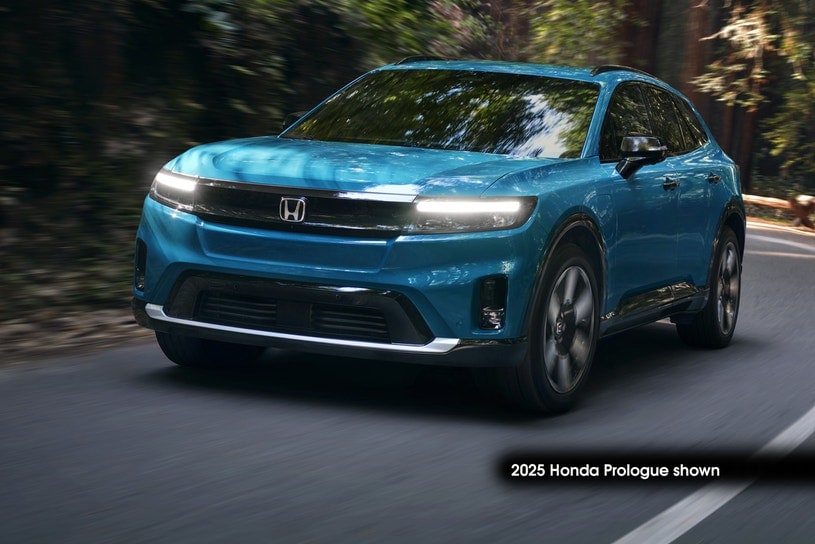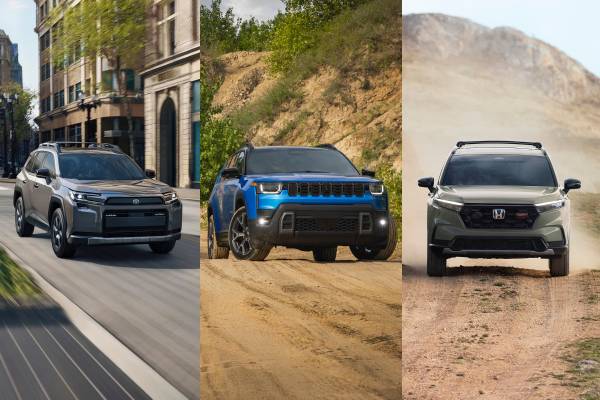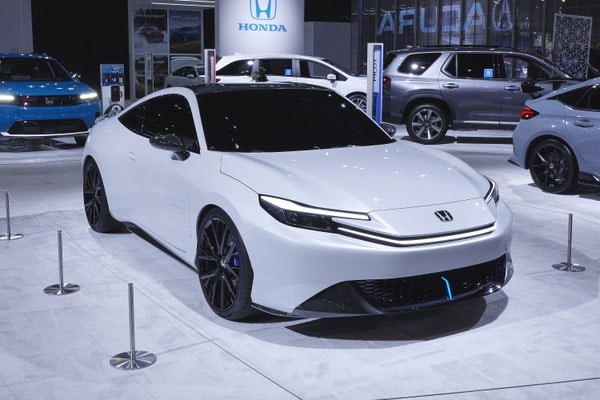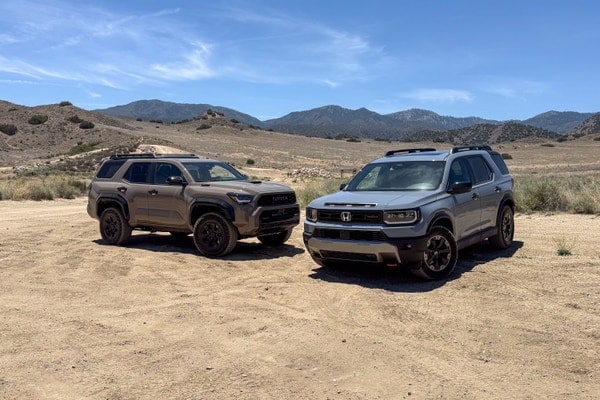2026 Honda Prologue
 View more photos
View more photos2026 Honda Prologue Review
Pros
- Long range for an electric SUV
- Plenty of passenger space
- Google-based infotainment system is helpful
Cons
- Middling handling and acceleration
- Stiff ride quality in top trim
- Hard to see out of the back
What's new
- No major changes expected for the 2026 Prologue
- Part of the first Prologue generation introduced for 2024
Overview
If you're in the market for an electric car and are dead set on a Honda, the Honda Prologue fits the bill. Sort of. You see, the Prologue is really a Chevy Blazer EV underneath, conceived at a time when Honda decided it had to have an EV in the lineup, and quickly. The result is an electric SUV that doesn't really look or feel like a Honda, but it does offer decent range, a comfortable ride, and a long list of standard features. But as its name suggests, the Prologue is merely an intro before Honda starts making its EVs in-house. With Honda set to start rolling out its homegrown 0 Series family of EVs in 2026, don't expect significant changes between now and whenever this electric crossover SUV transitions from prologue to coda status.
Edmunds spotlight: Prologue vs. Blazer
While the Prologue is inextricably linked to the Blazer EV, they aren't exactly the same. For one, the Blazer is available in a wider range of configurations. You can get it with a higher-capacity battery for increased range or even as a high-performance Blazer EV SS that produces an outlandish 615 horsepower. The Blazer EV offers Chevy's Super Cruise system, which is a helpful hands-free driving system that works on highways. In contrast, the Prologue has a streamlined lineup and doesn't come with Super Cruise. The Prologue's main advantage, besides its Honda badge, is that it comes with easy smartphone integration thanks to standard Apple CarPlay and Android Auto. Chevy doesn't include them on the Blazer EV.
Competitors to consider
Aside from the Blazer EV, there are numerous alternatives to the Honda Prologue. The Hyundai Ioniq 5 and related Kia EV6 are among the best, offering a broader lineup, including performance models and significantly quicker battery charging times. The updated 2026 Tesla Model Y is another great choice thanks to its roomy interior, spacious cargo areas, and satisfying performance and range. We also recommend checking out the Ford Mustang Mach-E and Volkswagen ID.4.
Edmunds Expert Rating
Driving experience
Visibility is another drawback for the Prologue. A low rear window and thick pillars significantly obstruct rearward views, though the Elite trim's surround-view camera system helps to offset this issue. Forward visibility fares slightly better thanks to strategically placed mirrors. Driver assistance features are functional but basic. Adaptive cruise control operates smoothly, and lane departure warnings are subtle but lack lane centering. Blind-spot monitoring is reliable, and the forward collision warning system works well, though it can feel overly sensitive.
Comfort
The Prologue offers ample space, comfortably accommodating 6-foot-tall passengers in all five seats. The rear seats include two recline settings, enhancing passenger comfort. Accessing the rear Isofix anchors and tethers is straightforward when installing car seats, and the flat floor design provides extra legroom (or bag room) for backseat passengers. However, despite its larger dimensions, the Prologue's interior doesn't feel noticeably more spacious than the Ioniq 5.
In-cabin tech
The Prologue provides plenty of connectivity, with two USB-C ports and a 12-volt outlet in both the front and rear rows. A wireless charging pad is included, though it struggles with phone cases. One downside is the lack of smartphone key functionality, which some EVs offer.
Storage & cargo
When it comes to towing, the Prologue has a significantly lower towing capacity (1,500 pounds) than rivals like the Tesla Model Y (3,500 pounds) and Hyundai Ioniq 5 (2,300 pounds). This limited capacity makes it less ideal if you do any sort of towing.
Value
Honda's warranty includes charging perks with three package options: the Home Charging Station (Level 2 charger, $500 installation credit, $100 EVgo credit), Portable Charging Kit (charger, $250 installation credit, $300 EVgo credit), or the Public Charging Credits ($750 EVgo credit). Owners also get 60 kWh of free charging at Electrify America stations and access to Tesla Superchargers (with an adapter) starting June 2025.
MPG
Recharging at home, the Prologue can accept up to 11.5 kW of power, which is what most homes can commonly support without extensive modification. We tested the Prologue's public fast-charging speeds and found that, under ideal conditions, it takes just over 18 minutes on average to add 100 miles of range. While that seems reasonable, this speed is relatively slow compared to competitors; for instance, the Ioniq 5 can achieve the same range boost in less than half the time.
X factor
2026 Honda Prologue trim level differences
[Editor's note: The following unofficial information is based on last year's Prologue. We expect the 2026 model will have a similar lineup and we'll update this section once we have complete information.] The Honda Prologue is available in three trim levels: EX, Touring and Elite. The EX and Touring come standard with a single electric motor driving the front wheels (220 horsepower, 243 lb-ft of torque). All-wheel drive, which adds a second motor, is available on the EX and Touring and is standard on the top Elite trim. The additional motor increases power to 300 hp and 355 lb-ft. All models draw energy from an 85-kWh battery pack.
Which Prologue trim does Edmunds recommend?
Honda hasn't released official information on the 2026 Prologue as of this writing. We'll update our recommendation if anything changes, but based on last year's Prologue, we suggest springing for the midrange Touring trim. It adds the convenience of a hands-free liftgate and dresses up the interior with several upgrades that include leather upholstery, premium audio and a panoramic sunroof.




2026 Honda Prologue video
Tesla Model Y vs. Honda Prologue vs. Hyundai Ioniq 5 vs. Chevy Equinox EV | Electric SUV Battle
NOTE: This video is about the 2025 Honda Prologue, but since the 2026 Honda Prologue is part of the same generation, our earlier analysis still applies.
Related 2026 Honda Prologue info
Similar Vehicles
Research more upcoming vehicles
- 2026 Subaru Ascent News
- 2026 Toyota Tacoma News
- 2026 Lexus ES News
- 2025 Bentley Bentayga News
- 2025 Toyota Corolla Cross News
Popular new car reviews and ratings
- New Ram 2500
- 2025 GMC Yukon
- Jeep Compass 2025
- 2025 Ford Bronco
- Jeep Cherokee SRT
- New Chevrolet Trax
- 2025 Mercedes-Benz E-Class
- 2025 Chevrolet Suburban
- New Honda Accord
- 2026 Honda Accord News
Vehicle rankings by type
Other Honda models to consider
- 2025 Honda Accord
- New Honda CR-V
- Honda Civic 2025
- 2024 Prologue
- 2024 Honda Odyssey
- Honda Ridgeline 2024
- 2024 Honda Accord
- 2025 Honda CR-V
- 2024 Honda Civic
Research other SUVs
Other models
- Used Mclaren MP4-12C in La Crosse, WI 2013
- Used Pontiac Sunbird in Wisconsin Rapids, WI 1994
- Used Audi E-Tron-Sportback in Nashua, NH 2023
- Used Honda Civic in Hemet, CA 2026
- New Mitsubishi Outlander-Sport for Sale in West Jordan, UT
- Used Mitsubishi Raider in Long Island City, NY 2009
- Used Hyundai Palisade in Newark, OH 2025
- Used Land-Rover Range-Rover in Hamtramck, MI 2025
- New Acura MDX for Sale in Hilton Head Island, SC
- Used Hyundai Palisade in Woodbridge, NJ 2025

